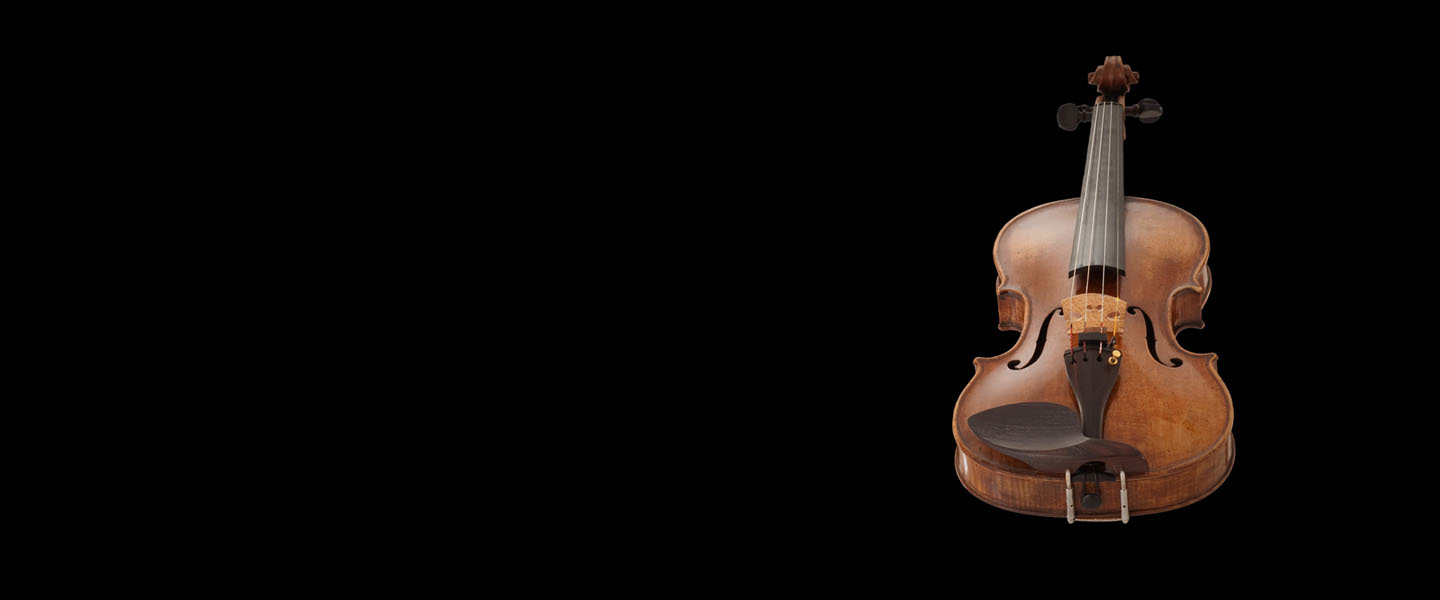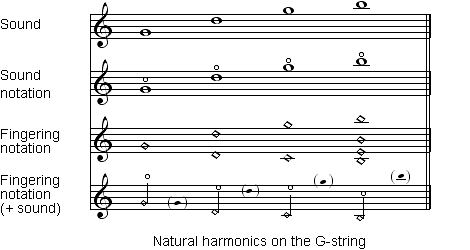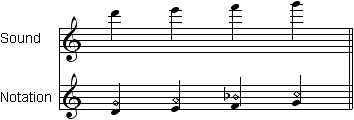How To Change The Pitch Of A Note Played On A Stringed Instrument

Violin - Notation
The violin is a not-transposing musical instrument notated in treble clef.
The variety of playing techniques used on stringed instruments means in that location are a number of features peculiar to violin notation.
Bowing note (right hand)
As a rule many bowstrokes which come under staccato are non notated simply played in the advisable manner by the violinist. If the composer desires a detail kind of bowstroke he writes it into the score.
Melodic phrases which are to be played with a single stroke are linked by a phrasing slur. The change of bowing tin occur on a unmarried annotation.

Détaché / Detached
Not–legato technique, strokes alternately up and down without the bow being lifted from the string.
i. Détaché or discrete is often written explicitly into the score.
2. Strong détaché is indicated past a dot above the annotation.
3. The strongest détaché consists solely of downstrokes. The bow is lifted from the string after every stroke.

Martelé
Hammered stroke (in Italian martellato = hammered).
Every stroke, whether up or downwardly, is ended abruptly, the bow remaining on the string.

Sul tasto and sul ponticello
Because of the event it has on timbre the place where the bow should brand contact with the string is oftentimes written into the score. Sulla tastiera (or sul tasto, sur la touche significant on the fingerboard, sul ponticello on the bridge.
Most playing techniques are possible both sul ponticello and sulla tastiera.
Col legno (with the wood, French: avec le bois)
Hitting or bowing the string with the wood of the bow. The first technique produces a hammer consequence and is used for repeated figures. The latter sounds croaky, rough and dry and is of indeterminate pitch.

Pizzicato
Plucked.
Changing from pizzicato to arco
The change from bowed (arco) to plucked (pizzicato) and back is ever written in full. (The office is to played pizzicato until arco is written).
"Bartók pizzicato" ("snap" pizzicato)
The string is lifted with two fingers of the correct hand so that it snaps dorsum onto the fingerboard when allow get. This produces a very resounding audio which is used for percussive furnishings. Annotation: a circle with a tail pointing either upward or down above each note.

Measured bowed tremolo
The repetition of a note with no emphasis or rhythm by means of very fast upward and downstrokes at the point. The impression given is of a "trembling" sound, which is used peculiarly for dramatic upshot and tonal intensification. Double stops can also exist played tremolo. The bow tremolo is usually measured, i.e. the number of strokes corresponds exactly to the notated division of the whole annotation value which determines the length of the tremolo. This kind of tremolo must be played in absolute synchronization by all the violinists. Freely playable tremolo as well exists.
Tremolos accept been part of the strings' standard repertoire of effects since the beginning of the 19th century.
Unmeasured bowed tremolo

Backside the bridge
The string is bowed betwixt the bridge and the string tuner.
An X is written on the staff at the pitch levels corresponding to the open up strings which are to exist played. The pitch heard is indeterminate, the different strings produce diverse pitches.
Notation for fingering (left hand)
Natural harmonic
At that place are three types of notation:
Pitch notation
A note with a small circumvolve above information technology indicates where the string were to be fingered if the "normal" note were being played. It is in this way that the fingering is notated that corresponds to the actual harmonic sounded. It is left to the musician'south discretion which node he or she chooses. (Harmonics tin be fingered at any ane of their nodes.) The cord is frequently indicated under the notation also (e.g., sul G).
Finger annotation
One of the possible fingerings (vibration nodes) is represented by a annotation in the form of a diamond. The fingering given is always the i that is easiest to perform (i.e. is nearest the nut). The sounding pitch of the harmonic cannot exist ascertained from this notation.
Fingering and pitch
Some composers add together the sounding pitch in brackets above the finger notation.

Artificial harmonics
The finger that firmly presses the string is notated every bit a pitch with the desired notation value. The finger that lies lightly on the string – generally a fourth above the stopping finger – is notated as an empty, "white" diamond, that is, they always expect like whole notes, regardless of the real note value.

Portamento
An audible slide of the finger along the string with accompanying change of position. The event is of two notes being joined together in a suggestion of a glissando.
![]()
Con sordino
Con sordino (with mute) calls for the use of the mute, which is not to exist removed until instructed to practise so by the term senza sordino.
Triple and quadruple stops
Triple stops (three-part chords) and quadruple stops (four-role chords) are notated as chords and played as arpeggiated chords (each note in quick succession, from the everyman to the highest note). When playing four-role chords, the two lowest notes are played first, then the two highest.

Pizzicato
Pizzicato with the left hand is indicated past a + above the notation. Alban Berg: Violin Concerto.
![]()
Finger tremolo
Two notes are played as a tremolo on the same string as follows: the finger in the lower position fingers the cord and keeps information technology pressed downward while the other finger quickly and repeatedly stops and releases a college note. In dissimilarity to the bow tremolo, when rapid up and downstrokes produce the tremolo effect, bowing hither is smooth and fifty-fifty over the cord. The result is a kind of trill.
![]()
Su una corda
The teaching to play a cantilena on a item cord (due east.g., sul G). Su una corda means "on 1 cord".
Source: https://www.vsl.co.at/en/Violin/Notation
Posted by: garcialuxual63.blogspot.com


0 Response to "How To Change The Pitch Of A Note Played On A Stringed Instrument"
Post a Comment